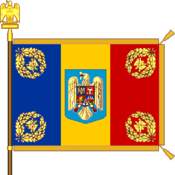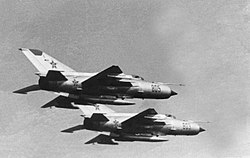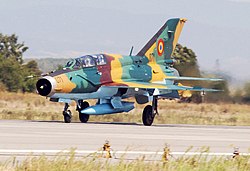| Romanian Air Force Forţele Aeriene Române | |
|---|---|
 The coat of arms and the identification flag | |
| Founded | 1st of April 1913 |
| Country | Romania |
| Size | 9,700 personnel[1] |
| Part of | Romanian Armed Forces |
| Command HQ | Statul Major al Forţelor Aeriene - Bucharest |
| Commanders | |
| Chief of the Air Force Staff | Lieutenant General Fănică Cârnu |
| Insignia | |
| Roundel |
 |
| Military colors |
 |
| Aircraft flown | |
| Attack | MiG-21 LanceR 'A', IAR-330 SOCAT |
| Fighter | MiG-21 LanceR 'C' |
| Reconnaissance | Antonov An-30, RQ-7 Shadow |
| Trainer | MiG-21 LanceR 'B', IAR-99, IAR 316, Yak-52 |
| Transport | C-130 Hercules, C-27J Spartan, Antonov An-26, IAR-330L/M Puma |
The Romanian Air Force (Romanian language: Forţele Aeriene Române ) is the air force branch of the Romanian Armed Forces. It has an air force headquarters, an operational command, four air bases and an air defense brigade. Reserve forces include two air bases and three airfields.
In 2010, the Romanian Air Force employed 9,700 personnel.
Current state[]
The Romanian Air Force modernized 110 MiG 21 LanceRs, in cooperation with Israel between 1993 and 2002. Today, 48 of these MiG 21 LanceRs are operational.[2] The Romanian Air Force also operates C-130 Hercules, C-27J Spartan, An-26s transport planes and IAR-330 Puma helicopters. IAR-330 PUMA SOCAT helicopters have been modernized by the Romanian Aviation Industry in cooperation with Elbit Systems (Israel) for attack missions. The Romanian Air Force also includes native-made IAR-99 Şoim jet planes, in general only used for training of the young pilots. The remaining MiG-29s have been removed from service in 2003.
Due to the old age of the MIGs, the Romanian Air Force is considering procurement of new fighters, or possibly used fighters as an interim solution. Romanian Defense Minister Corneliu Dobritoiu said his country aims to buy an undisclosed number of second-hand F-16A/B jet fighters from Portugal. Earlier this year, local media reported that Romania sought to buy used F-16s from the Netherlands, but the plan was eventually scrapped. In March 2010, Romanian President Traian Basescu told local media the government was considering the purchase of 24 second-hand F-16s from the U.S. for about $1.3 billion.
In the spring of 2009, the Romanian government decided to purchase VSHORAD/SHORAD systems from France.[3] The deal included Mistral MANPADS and MICA VL surface-to-air missiles.[4] However, after preliminary talks with MBDA in August, the deal was put on hold and canceled afterwards because of the defense cuts.[5]
In February 2010, the Supreme Council of National Defense signed an agreement with the United States for missile defense under whose terms land-based SM-3 systems would be installed in Romania. On the 3rd of May 2011, the president of Romania Traian Băsescu announced the location for the SM-3 systems. They will be installed at the former Air Force base Deveselu in Olt County.[6] The system includes 3 batteries with 24 SM-3 Block I rockets, manned by approximately 200 US soldiers (with a maximum of 500) under Romanian Air Force overall command.
The current chief of the Romanian Air Force Staff, succeeding General Ion-Aurel Stanciu on 7 January 2011, is Major General Fănică Cârnu.
History[]
  |
| History |
|---|
| Royal Romanian Air Force |
| List of WWII flying aces |
| Aircraft |
| List of Romanian Air Force aircraft |
| Structure |
| List of Air bases |
| List of squadrons/other units |
| Personnel |
| Officer ranks |

Aurel Vlaicu in his Vlaicu I prototype.
Beginnings[]
Romania was one of the first countries in the world to have an air force, starting with 1913. In 1912, the Romanian Air Force commissioned 10 Vlaicu I aircraft, built by Aurel Vlaicu in Bucharest.
World War I[]
During World War I, Romania acquired 322 aircraft from France and Great Britain including: Nieuport fighters (types 11, 17 12, 19, 21, 23, 24 and 28), Farman reconnaissance and light bombing aircraft (types 40 and 46), and Breguet-Michelin heavy bombers. On September 16, 1916, a Romanian Farman F.40 shot down an Imperial German Air Force aircraft near Slobozia; this was the first victory in the history of the Romanian Air Force. By the end of World War I, Romanian pilots had achieved about 11,000 hours of flight and fought 750 air battles.
Golden Age[]
During the interwar period, the RoAF, second only to Poland among the future Warsaw Pact countries, had a powerful national aircraft industry which designed and produced all types of military and most civil aircraft. In particular the IAR 80 series were stressed-skin fighters, worthy to rank with the other single-seat fighters of WWII, and used in significant numbers on the Eastern Front.
The RoAF was reorganized during an 18-year period. Over 2,000 military and civil aircraft were built in Romania, based on native or licensed designs. The military aviation used IAR 80 fighters, which became famous on the Eastern Front, and bombers manufactured by IAR Braşov. Messerschmitt Bf 109 and Heinkel He 112 fighters, Heinkel He 111 and Junkers Ju 88 bombers, Junkers Ju 87 dive bomber, Junkers Ju 52 transport and Heinkel He 114 seaplanes were purchased from Germany in the interwar period.
World War II[]

A pair of IAR-80 fighters on patrol during World War II
When Romania, allied with Nazi Germany, went to war against the USSR, on June 22, 1941, the Romanian Air Force had 621 airplanes, including its native made fighter IAR 80/81. The air force accomplished hundreds of missions, contributing to Romania's recapture of Northern Bucovina and Basarabia, which had been occupied by the Soviet Union a year earlier. Until the Odessa episode[Clarification needed], the Romanian military fighters gained 661 air victories. Romanian Military Aviation fought on the Eastern front until August 22, 1944, bringing an important contribution to the great battles in Stalingrad, Crimea, and the Ukrainian fronts. Between 1941-1944 Romanian aircraft won 2,000 air victories. The most famous flying aces were Captain Prince Constantin Cantacuzino, who gained 68 certified victories, Captain Horia Agarici and Captain Alexandru Şerbănescu, who shot down 60 enemy airplanes.
Cold War[]

A pair of Romanian MiG-21 fighters during late 70's.

Romanian Air Force MiG-29, currently retired and in storage since 2003.
Starting with 1948, Romania tailored its military to Soviet concepts and doctrine. On February 15, 1949, the Aviation Command was established based on the Soviet model (regiments instead of flotillas). New Soviet aircraft, such as Yakovlev Yak-18, Polikarpov Po-2, Lavochkin La-9, Tupolev Tu-2, and Ilyushin Il-10 entered service. A year later, 77 Yakovlev Yak-17s and Yakovlev Yak-23s entered the air force, and in 1952, other 88 aircraft: MiG-15 and MiG-17. In 1958, the first supersonic fighter MiG-19 entered the inventory. Three years later, in February 1962, a new fighter was added to the inventory, MiG-21, which represented one of the most effective fighters of that time.
Starting with 1974, Romanian-made aircraft supplemented the already existing jets. The Romanian IAR-93 subsonic aircraft flew its first flight on 31 October 1974. It represented a great step forward taking into account that it was the only jet fighter not made by the Soviets, the only one ever manufactured and operated by a Warsaw Pact country.
In 1962, the first helicopter subunits were established and followed later on, in 1965, by the first Soviet Mi-2 and Mi-4 helicopters. Renewing the aircraft fleet process went on, the first 12 MiG-23s entering the service between July–September 1979.
On 14 May 1981, at 20:16, Soviet spaceship Soyuz-40 was launched from Baikonur to perform a common Romanian-Soviet flight, with Lieutenant Dumitru Prunariu and Colonel Leonid Popov as commander on board. During the early 80's 67th Fighter-Bomber Regiment and 49th Fighter-Bomber Regiment from Craiova and Ianca were equipped with new IAR-93 attack aircraft which have replaced old MiG-15s and MiG-17s. In December 1989, just a few days before the Romanian revolution against communism began, MiG-29 aircraft had entered the Air Force inventory.
2007 Baltic Air Policing[]

A pair of MiG-21 LanceR 'C's of the 71st Air Flotilla ready to take off in Lithuania.
Four MiG-21 LanceR Cs were deployed from August 2007 to November 2007 at Šiauliai, in Lithuania for Baltic Air Policing. The Romanian detachment succeeded the French Air Force Mirage 2000Cs of Escadron de Chasse 01.012 from Cambrai, which fulfilled the Baltic Air Policing since May 2007. Once the RoAF finished its three-month stint, a Portuguese Air Force detachment took over the mission.[7]
The four aircraft and most of the staff came from the 71st Air Base. A total of 67 personnel, among them nine pilots, were part of the detachment: 63 served at Šiauliai, while other four served at the air traffic control centre in Kaunas, to ensure smooth cooperation with local authorities. The Romanian detachment attracted attention from the local media, not least from the fact that it was only the second time a fighter from the Soviet era deployed to Šiauliai - Polish Air Force MiG-29s have also been deployed there in 2006.[8]
2007 Romanian Air Force IAR-330 SOCAT crash[]
Three people were killed on November 7, 2007, when an IAR-330 Puma SOCAT attack helicopter belonging to the 90th Airlift Base crashed in Ungheni, near Piteşti, Argeş County. The aircraft was doing a night training mission at the moment of the crash.[9]
Structure[]
Air Force Staff[]

Romanian Air Force IAR-330 SOCAT

Antonov An-26 landing at 90th Airlift Base.

MiG-21 LanceR 'B' of Romanian Air Force, arrives in support of the Partnership for Peace Exercise Cooperative Key 2003 at Graf Ignatievo Air Base in Bulgaria

IAR-99 Şoim

SA-2 M3 "Volhov" system launching a 5Ia23 missile at Capu Midia firing range.
The Romanian Air Force Staff represents the military concept-developing, command and executive structure providing Air Forces peacetime, crisis and wartime leadership in order to reach, maintain and increase, as required, the operational level of the military subordinated structures so that to be able to operate under authorized commands responsible for military operations planning and conduct.
Generate, mobilize, structure, equip, operationalize and regenerate the required forces, provide the logistic support necessary to conduct military operations and based on higher orders, take over both the Joint Operation Air Component and independent air operations command and control, through the Main Air Operational Center. Starting with July 1, 2010, the Romanian Air Force bases were renamed to Air Flotillas.[10]
Air bases[]
The Romanian Air Force has 5 active air bases:[11]
File:Bz71.gif 71st Air Flotilla - Câmpia Turzii
- 711th Fighter Squadron - operating MiG-21 LanceR A, B;
- 712th Fighter Squadron - operating MiG-21 LanceR B, C;
- 713th Helicopter Squadron - operating IAR-330L/M;
- 714th Helicopter Squadron - operating IAR-330L/M (located at Timisoara Airport - former 93rd Air base);
File:Bz86a.gif 86th Air Flotilla - Feteşti
- 861st Fighter Squadron - operating MiG-21 LanceR B, C;
- 862nd Fighter Squadron - operating MiG-21 LanceR A, B;
- 863rd Helicopter Squadron - operating IAR-330L/M (located at Mihail Kogălniceanu Airport - former 57th Air Base);
File:Bz95a.gif 95th Air Flotilla - Bacău
- 951st Fighter Squadron - operating MiG-21 LanceR A, B;
- 205th School Fighter Squadron - operating MiG-21 LanceR A, B;
- 952nd Helicopter Squadron - operating IAR-330L/M;
File:Ro-90baza.gif 90th Airlift Flotilla - Bucureşti - Otopeni
- 901st Strategic Transport Squadron - operating C-130 Hercules B,H;
- 902nd Transport and Reconnaissance Squadron - operating An-26, An-30 and C-27J Spartan;
- 903rd Transport Helicopter Squadron - operating IAR-330L/M;
- 904th Attack Helicopter Squadron - operating IAR-330 SOCAT;
- 905th Attack Helicopter Squadron - operating IAR-330 SOCAT;
142nd Reconnaissance Squadron - Timișoara - Giarmata - operating Shadow 600 UAVs
File:Safa.jpg "Aurel Vlaicu" Flight School - Bobocdisambiguation needed
- 201st School Squadron - operating Yakovlev Yak-52;
- 202nd School Squadron - operated Antonov An-2 until July 2010;
- 203rd School Squadron - operating IAR-99 Standard;
- 204th School Squadron - operating IAR-99 Şoim;
- 206th School Squadron - operating IAR-316B Alouette III;
Reserve air bases[]
- Constanţa - Mihail Kogălniceanu Airport - 57th Air Base
- Timişoara - Giarmata Airport - 93rd Air Base
There are also 3 airfields included in the reserve forces.
Units[]
 1st SAM Brigade "General Nicolae Dăscălescu" - located near Bucharest;
1st SAM Brigade "General Nicolae Dăscălescu" - located near Bucharest;- File:REG 11AA.jpg11th SAM Regiment "Horea" - located near Braşov
- 91st Logistics Base - Bucharest
- 70th Aviation Engineer Regiment - Bucharest
- 85th Signal Battalion - Curtea de Argeş
Capu Midia range[]
The Capu Midia training camp and surface to air firing range provides firing training, execution and evaluation facilities. It is located in Constanţa County, 20 km north from the county capital, Constanţa.
Aircraft inventory[]
| Aircraft | Photo | Origin | Type | Versions | In service[12] | Notes |
|---|---|---|---|---|---|---|
| Fixed-wing Aircraft | ||||||
| MiG-21 LanceR | 
|
Fighter Aircraft | MiG-21 LanceR A | 36[13] | ground attack[14] | |
| Trainer Aircraft | MiG-21 LanceR B | |||||
| Fighter Aircraft | MiG-21 LanceR C | [1] air superiority[14][15] | ||||
| An-30 Clank | 
|
Reconnaissance Aircraft | An-30 | 2[13] | aerial cartography for Treaty on Open Skies. | |
| C-27J Spartan | 
|
Cargo/Transport Aircraft | C-27J | 6[1] | 1 more to be delivered in early 2014[16][17] | |
| C-130 Hercules | 
|
United States | Cargo/Transport Aircraft | C-130H | 3[13] | |
| IAR 99 Şoim | 
|
Trainer Aircraft | IAR-99
IAR-99C |
10[1]
11[1] |
||
| Yak-52 | 
|
Trainer Aircraft | Yak-52 | 12[1] | licensed built Yak-52 by Aerostar | |
| Helicopters | ||||||
| IAR 316 Alouette III | 
|
Training Helicopter | IAR-316 | 6[1] | a squadron remains operational with the training unit at Boboc | |
| IAR 330 Puma | 
|
Utility Helicopter | IAR-330 | 35[1] | ||
| Attack Helicopter | IAR-330 SOCAT | 22[1] | 25 initially, 3 crashed | |||
| Other | ||||||
| RQ-7 Shadow | United States | UAV | Shadow-600 | 7 | 11 initially, 4 crashed (1 in country, 3 in Iraq) | |
| S-60 | 
|
anti-aircraft gun | CRT 1RL-35M1 | 250 | Will be replaced with SHORAD systems. Still used for training as of 2010. | |
| MIM-23 Hawk | 
|
United States | surface to air missile | Hawk XXI | 224 | 8 batteries[1] |
| S-75 Dvina | 
|
surface to air missile | S-75 M3 "Volhov" | 6 batteries;[1] 18 or 20 initially delivered by USSR between 1963–1967, modernized three times since then.[18] Towed by Soviet era ZIL 131 trucks | ||
| AN/FPS-117 | 
|
United States | radar | AN/FPS-117E (T) | 5 | 3-dimensional air search radar; in service since 1998 |
| P-18 radar | 
|
radar | P-18 | 2-dimensional air search radar; in service since 1977; mounted on Ural-375D chassis | ||
| P-37 Bar Lock | 
|
radar | P-37 Bar Lock | 2D E band/F band radar; in service since 1975 | ||
| TPS-79 | 
|
United States |
radar | TPS-79(R) | 19 | 3-dimensional air search radar.[19] in service since late 2004. Towed by DAC 665 T utility truck |
| PRV-13 | 
|
Radar altimeter | PRV-13 | In service since 1978 | ||
Future[]
- Romania is to acquire 12 A/B block 15 OCU General Dynamics F-16 Fighting Falcon from Portugal, interested in 9 more from the same source.
Aircraft markings[]
The Romanian roundel has the same colours as the Romanian flag. The innermost circle is blue, followed by yellow, and then red. It is placed on Romanian Armed Forces vehicles and Romanian Air Force aircraft.
Ranks and insignia[]
See also[]
References[]
Notes[]
- ↑ 1.00 1.01 1.02 1.03 1.04 1.05 1.06 1.07 1.08 1.09 1.10 International Institute for Strategic Studies, The Military Balance 2010, page. 158
- ↑ 9am.ro, Bătălia giganţilor pentru aviaţia militară românească ("Battle of giants for the Romanian Air Force"), from Ziua, November 7, 2005
- ↑ Romania reveals VL MICA order, SURFACE-TO-AIR
- ↑ Cer Senin Magazine, nr. 3/2009, page 10
- ↑ Defense under external pressure
- ↑ Băsescu announces the location of the US rockets
- ↑ Air Forces Monthly, November 2007 issue, p.36.
- ↑ Air Forces Monthly, November 2007 issue, p.37.
- ↑ Helicopter crashed near Pitesti killing three people aboard, Antena 3, November 7, 2007.
- ↑ http://www.financiarul.ro/2010/07/02/romanias-air-force-staff-to-be-overhauled-starting-july-1-2010/
- ↑ http://www.scramble.nl/mil/2/far/orbat.htm
- ↑ "World Air Forces 2013". Flightglobal.com, 11 December 2012.
- ↑ 13.0 13.1 13.2 "World Air Forces 2013". Flightglobal Insight. 2013. http://www.flightglobal.com/airspace/media/reports_pdf/emptys/101015/world-air-forces-2013.pdf. Retrieved 12 April 2013.
- ↑ 14.0 14.1 (Romanian) "MiG 21 on RoAF"
- ↑ "Romania to buy second-hand F-16 fighter jets"
- ↑ Romania's First C-27J prepares for delivery, Air Forces Monthly magazine, p. 13, September 2009 issue.
- ↑ Romania accepts first C-27J Spartans
- ↑ Romanian Air Force
- ↑ Gap Filler (RoAF.ro)
Bibliography[]
- Bernád, Dénes. Rumanian Aces of World War 2 (Aircraft of the Aces 54). Botley, Oxford, UK: Osprey Publishing, 2003. ISBN 1-84176-535-X.
- Bernád, Dénes. Rumanian Air Force: The Prime Decade, 1938-1947. Carrollton, TX: Squadron/Signal Publications Inc, 1999. ISBN 0-89747-402-3.
- Crăciunoiu, Cristian and Roba, Jean-Louis. Romanian Aeronautics in the Second World War, 1941-1945 (bilingual Romanian/English). Bucureşti, Romania: Editura Modelism International Ltd, 2003. ISBN 973-8101-18-2.
- International Institute for Strategic Studies; Hackett, James (ed.) (2010-02-03). The Military Balance 2010. London: Routledge. ISBN 1-85743-557-5.
External links[]
| Wikimedia Commons has media related to Romanian Air Force. |
- Official site of the Romanian Air Force
- Official site of the Romanian Ministry of National Defense (MoND)
- Order of Battle of the RoAF
| |||||||||||||
| |||||
| |||||||||||
| ||||||||
The original article can be found at Romanian Air Force and the edit history here.



